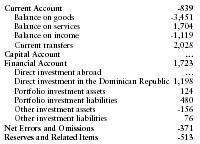Dominican Republic - Balance of payments
For more than 20 years prior to 1961, the Dominican Republic had no internal or external debt. In 1961, however, about US $70 million was taken out of the country by the Trujillo family and others. Political instability induced further net outflows of private capital throughout the 1960s. The nation's current accounts position worsened during the 1970s, as trade deficits grew. Declines in export earnings in the 1980s brought shortages of foreign exchange. Large increases in imports and a sharp drop in commodity exports pushed the merchandise trade deficit to over $1.6 billion by the end of 1992, and $1.4 billion in 1998. Tourism (now the country's largest foreign exchange earner), expatriate remittances, and earnings from the free trade zones help to finance the trade deficit. Foreign direct investment as of the early 2000s was likely to remain high.
The US Central Intelligence Agency (CIA) reports that in 2001 the purchasing power parity of the Dominican Republic's exports was $5.5 billion while imports totaled $8.7 billion resulting in a trade deficit of $3.2 billion.
The International Monetary Fund (IMF) reports that in 2001 the Dominican Republic had exports of goods totaling $5.33 billion and imports totaling $8.78 billion. The services credit totaled $3 billion and debit $1.3 billion. The following table summarizes the Dominican Republic's balance of payments as reported by the IMF for 2001 in millions of US dollars.

| Current Account | -839 |
| Balance on goods | -3,451 |
| Balance on services | 1,704 |
| Balance on income | -1,119 |
| Current transfers | 2,028 |
| Capital Account | … |
| Financial Account | 1,723 |
| Direct investment abroad | … |
| Direct investment in the Dominican Republic | 1,198 |
| Portfolio investment assets | 124 |
| Portfolio investment liabilities | 480 |
| Other investment assets | -156 |
| Other investment liabilities | 76 |
| Net Errors and Omissions | -371 |
| Reserves and Related Items | -513 |
Comment about this article, ask questions, or add new information about this topic: